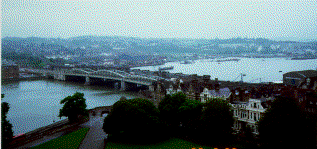
River Medway

River Medway
Images, courtesy of Debbie, Charles Dickens and Chalk Village
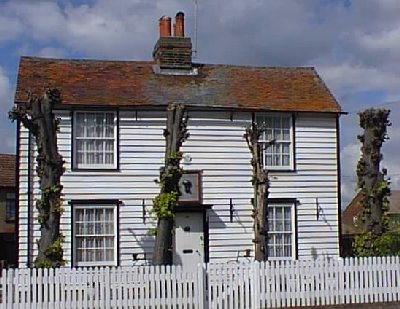
Craddock's Cottage. Dickens 1836 honeymoon retreat.
Charles Dickens came to Chalk, this quiet little village immediately after his marriage to Catherine Hogarth in April 1836. There is a plaque on an old timber boarded house in the High Street, claiming it to be their honeymoon cottage, although the original is more likely to have stood opposite.
Dickens was working on the early chapters of Pickwick Papers. Kate was already pregnant, so he would take a break from his writing and leave her resting whilst he pursued his passion for walking. Striding off alone across the marshes to Cravesend, Dickens always stopped on his return to raise his hat and greet the comical old gargoyle the remains of which can be seen above the entrance porch of Chalk Church.
A year later, after the birth of their first son they returned to Chalk for a holiday.
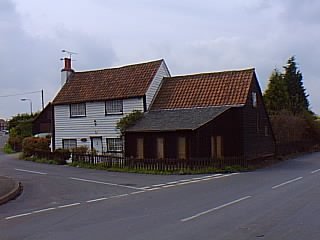
The Forge, Chalk Village 1998.
At the end of the High Street is an old forge and cottage believed to be the inspiration for the home of Joe Gargery, that simple, gentle giant of a village blacksmith, who is such a friend and ally to Pip in Great Expectations.
Access to the church and an uninterrupted view across the marshes to the river, is gained from the other end of the High Street by turning left for a few yards along the A226, and left again down Church Road.
Chatham
Off the A2 east of and adjoining Rochester
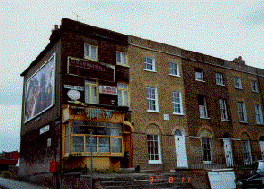 Dickens was barely five years old when his family arrived in Chatham. His father was a minor clerk in the Navy pay office. This once busy base is now preserved as the Chatham Historic Dockyard and appears in scenes from A Tale of Two Cities and commands a whole descriptive chapter in The Uncommercial Traveller.
Dickens was barely five years old when his family arrived in Chatham. His father was a minor clerk in the Navy pay office. This once busy base is now preserved as the Chatham Historic Dockyard and appears in scenes from A Tale of Two Cities and commands a whole descriptive chapter in The Uncommercial Traveller.
At Chatham, the young Dickens spent six of his most impressionable years--the first four in a house at No. 2 (now No. 11) Ordnance Terrace, and later in a smaller cramped "House on the Brook" in St. Mary's Place, now demolished. Understandably Chatham is often mentioned by him later and is represented as Mudfog in "The Mudfog Papers" and Dullborough in The Uncommercial Traveller.
For a while Dickens attended Mr. Giles' School that stood in Clover Lane and in Dombey and Son he based the character of Paul Dombey's teacher, (Mr. Feeder B.A.) on the schoolmaster William Giles.
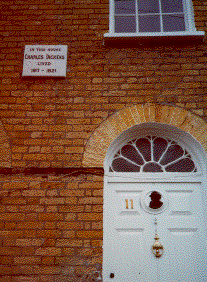
Dickens well remembered The Mitre Inn, now gone, where he and his sister used to sing sea shanties on the dining room table and where in 1822 due to the family's dire financial circumstances he was forced to board the London bound coach, "Blue-Eyed Maid". In Edwin Drood, The Mitre appears as "The Crozier" that "hotel of a most retiring disposition" where the mysterious Dick Datchery stays, it is also associated with the childhood of Charley in The Holly-Tree Inn (Christmas Stories).
Chatham is the setting for the Pickwickians' first meeting with Mr. Wardle and family and of Mr. Winkle's abortive duel with Dr. Slammer. It is also mentioned in "The Seven Poor Travellers" (Christmas Stories) and a weary little David Copperfield, on his way to visit his Aunt Betsey Trotwood in Dover, finds himself toiling into Chatham . . . and selling some of his clothing there.
Cobham
1 mile south of the A2 on the B2009
The pretty village of Cobham is to be found four miles to the west of Rochester.
As a boy, Dickens would often walk with his father from their home in Chatham, up to and through Shorne Woods and the park of Cobham Hall. He remembers this so pleasantly in Pickwick Papers.
"A delightful walk it was . . . through a deep and shady wood, cooled by the light wind which gently rustled the thick foliage, and enlivened by the songs of the birds...they emerged upon an open park, with an ancient hall, displaying the quaint and picturesque architecture of Elizabeth's time
The Hall belonged to Lord Darnley, a friend of Dickens, and is the setting for a ghost story in "The Holly-Tree Inn" (Christmas Stories). Dickens was still enjoying these same woods and green shades at the end of his life, and in fact, he took a walk through the park on the day before he died.
Mr. Pickwick and his two disciples, on their mission to convert Mr. Tupman from his resolution to forsake the world, arrived at Cobham, and entered that "clean and commodious village alehouse", the Leather Bottle, there they found Mr. Tupman sitting at a table which was, "well covered with a roast fowl, bacon, ale, and et ceteras". Opposite and overlooking the inn is the old church yard where Pickwick and his young friend paced among the graves in earnest conversation.
The food is still good at the Leather Bottle which remained one of Dickens's favourite places. Today the walls are decorated with an extensive collection of Dickensian memorabilia including, pictures, cartoons, photographs and illustrations.
The almshouses at Cobham College were probably Titbull's almshouses in The Uncommercial Traveller.
Cooling
5 miles north of Rochester on the B2000
This bleak marsh country of the North Kent Coast, described by Dickens as "raw" and "savage" is the setting for the spellbinding opening chapters of Great Expectations.
In Cooling churchyard there are two rows of lozenge shaped stones marking the graves of thirteen children from one family, all dead before their second year. Dickens adopts these as the departed brothers of his central character and narrator Pip.
Towards nightfall, on a cold Christmas Eve Pip visits the overgrown churchyard and encounters the terrifying Magwitch, who threatens to cut out his liver and eat him alive. The desperate convict has escaped from one of the moored prison hulks that were once an accepted part of this haunting "leaden" landscape.
Gadshill
Between Gravesend & Rochester on the A226
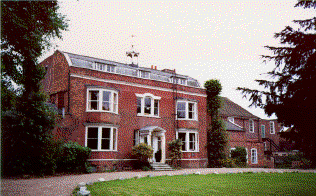
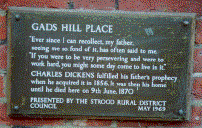 Gadshill held a fascination for Dickens from his childhood days, when on walks up from Chatham with his father they would stop to admire the impressive house on the hill at Higham known as Gadshill Place. He recalls in The Uncommercial Traveller meeting a vision of his former self on this road to Canterbury, and, "the very queer, small boy" saying, "I can recollect, my father, seeing me so fond of it, (the house) has often said to me, if you were to be very persevering, and were to work hard, you may someday come to live in it. Though that's impossible!"
Gadshill held a fascination for Dickens from his childhood days, when on walks up from Chatham with his father they would stop to admire the impressive house on the hill at Higham known as Gadshill Place. He recalls in The Uncommercial Traveller meeting a vision of his former self on this road to Canterbury, and, "the very queer, small boy" saying, "I can recollect, my father, seeing me so fond of it, (the house) has often said to me, if you were to be very persevering, and were to work hard, you may someday come to live in it. Though that's impossible!"
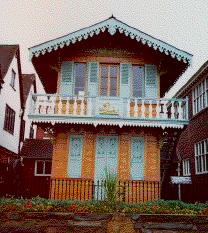 In 1856, Dickens did indeed have the opportunity to purchase Gadshill Place. He chose a snug ground floor room for his study and when the weather was good he wrote in a miniature Swiss Chalet in the garden. The Chalet was a present from his actor friend Charles Fechter. Dickens installed it in the grounds on the far side of the road from the house, and built a communicating tunnel which still runs under the present highway. The Chalet can now be seen in the grounds of the Dickens House Museum in Rochester.
In 1856, Dickens did indeed have the opportunity to purchase Gadshill Place. He chose a snug ground floor room for his study and when the weather was good he wrote in a miniature Swiss Chalet in the garden. The Chalet was a present from his actor friend Charles Fechter. Dickens installed it in the grounds on the far side of the road from the house, and built a communicating tunnel which still runs under the present highway. The Chalet can now be seen in the grounds of the Dickens House Museum in Rochester.
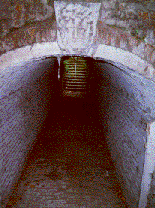 Dickens also relished the fact, and never tired of pointing out to his guests, that this was the very spot on which Shakespeare had set the scene of Falstaff's Highway robbery in Henry IV. Among the literati who enjoyed Cadshill hospitality were Hans Christian Anderson, the American poet Longfellow and that pioneer of detective stories Wilkie Collins.
Dickens also relished the fact, and never tired of pointing out to his guests, that this was the very spot on which Shakespeare had set the scene of Falstaff's Highway robbery in Henry IV. Among the literati who enjoyed Cadshill hospitality were Hans Christian Anderson, the American poet Longfellow and that pioneer of detective stories Wilkie Collins.
Dickens died at Gadshill on the 9th of June 1870. During his time at the house he produced a steady stream of wonderful novels and stories including; A Tale of Two Cities, Great Expectations, Our Mutual Friend, The Uncommercial Traveller and the unfinished The Mystery of Edwin Drood which he was working on the day before his death.
Gravesend
7 miles east of Dartford on the A226
Gravesend was one of the earliest resorts, and even today retains the air of a bustling seaside town. Here over the centuries the world's shipping has awaited the tide before approaching London (22 miles upstream).
This busy port was well known to Dickens and is the setting in a number of his stories. There are scenes of Gravesend in the The Uncommercial Traveller and in David Copperfield, David and Peggotty make their farewells here to emigrants, Mr. Peggotty, Ham and the Micawber family when they sail for Australia. In Great Expectations it is from Gravesend that Pip and his friend Herbert Pocket make their attempt to smuggle the convict Magwitch out of England.

 Top of Page
Top of Page
 Matsuoka's Home Page
Matsuoka's Home Page 
